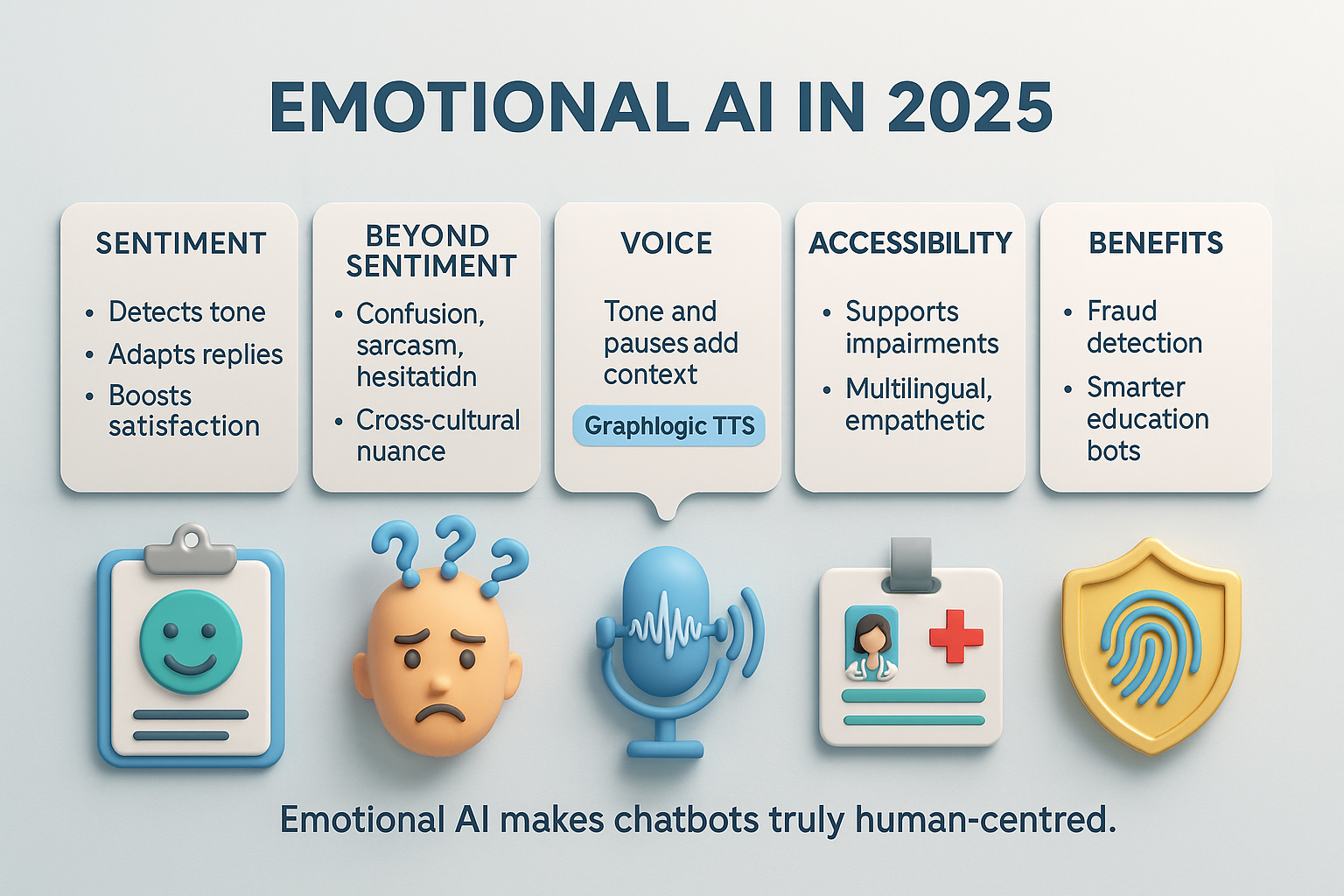In 2025 chatbots are no longer experimental add-ons. They are central to communication in healthcare, finance, retail and education. Millions of people rely on them for answers, scheduling, shopping, or even medical triage. To know if they actually help, organizations depend on chatbot analytics. Metrics show when a chatbot is efficient, where it fails, and how it shapes customer trust. Without metrics businesses are left guessing.
Evidence from Harvard Business Review shows that most failed chatbot projects collapsed because they did not measure engagement or resolution data. Without this foundation, improvement is random. With systematic tracking, chatbots move from novelty to trusted tool.

Core Metrics Every Business Needs
Engagement and Retention
The most direct signal of value is engagement. Engagement rate shows the percentage of users who continue beyond the first message. If only 10% of users proceed past the greeting, the system is not offering real value. When the engagement rate is above 50% businesses usually see higher satisfaction and more conversions.
Return users are another key metric. A customer who comes back is one who trusts the chatbot. If return rates reach 25% or more it is a sign that the chatbot has become a real channel rather than a one time experiment.
Conversation frequency reflects the depth of interaction. If the average user has 4 or 5 conversations each month it suggests the bot is providing consistent utility.
According to McKinsey companies that track these indicators carefully often report up to 30% improvements in customer satisfaction.

Performance and Resolution
Performance metrics reveal how effective a chatbot is at solving problems. Escalation rate shows the percentage of conversations transferred to human agents. If the rate is 40% the chatbot is struggling with complexity. If it falls to 15% after retraining the system is learning successfully.
First contact resolution shows how many queries are solved without follow up. A rate above 70% indicates high efficiency.
Average conversation length is also important. A customer support bot that maintains conversations with 6 or more exchanges often shows deeper interaction quality. However if conversations stretch far beyond that without resolution it becomes a sign of inefficiency.
Compliance and Privacy as Cornerstones
Legal Requirements Are Not Optional
User trust depends on compliance. Regulations such as GDPR in Europe and CCPA in California require consent before data is processed. Companies must track metrics such as consent rate and data anonymization effectiveness. A consent rate of 95% or more shows users understand and accept the terms.
Anonymization effectiveness is equally critical. If personal identifiers are consistently removed, data analysis becomes safer and compliant.
Lessons from Healthcare and Banking
In healthcare, compliance is central. Research from NIH demonstrates that patients engage more when privacy practices are transparent. Banks follow similar practices by masking IP addresses or encrypting conversation logs. Without visible privacy measures, adoption stalls.

Linking Metrics to Business Outcomes
Measuring Commercial Impact
Metrics also drive revenue. Conversion rate shows the percentage of conversations that result in a purchase or booking. A chatbot that converts 15% of interactions directly impacts the bottom line.
Lead generation rate measures how many users share contact information. If a retail chatbot increases qualified leads by 35% sales pipelines grow significantly.
Goal completion rate measures the percentage of users who complete tasks like filling a form or scheduling an appointment. When this number grows, customer journeys become smoother.
Return on investment also depends on these numbers. A company spending $500,000 per year on chatbot technology needs to show measurable outcomes such as reduced call center volume or increased revenue.
Platforms for Advanced Insight
Advanced systems such as the Graphlogic Generative AI & Conversational Platform integrate predictive analytics. These platforms do not just report data but anticipate user needs. By predicting intent they allow companies to respond proactively.
Perfect, let’s expand that section with more depth, rare details, and expert commentary, while keeping the same journalistic tone, without dashes, and with clear subheadings. Here is the enriched version:

Emotional AI and Future Use Cases
Sentiment as a Metric
Sentiment analysis is no longer experimental. It measures the emotional tone of a user’s message and adapts responses in real time. A chatbot that detects frustration can shift to a calmer and more supportive tone, while a chatbot that identifies enthusiasm can encourage faster action. This responsiveness has measurable effects. According to Frontiers in Psychology, systems that integrate sentiment adaptation see significant gains in satisfaction and engagement.
The practical impact is visible in sectors that deal with high stress interactions. In healthcare, patients often describe symptoms with anxiety. A chatbot that recognizes negative sentiment and provides reassurance improves adherence to medical advice. In banking, recognizing irritation during a balance inquiry can prompt the system to escalate to a human agent more quickly, preventing customer churn.
Sentiment as a metric also helps companies refine scripts and training data. If 30% of conversations in a given flow generate negative sentiment, this is an actionable signal. It tells product managers exactly where the experience fails. Companies can then retrain models or redesign questions, reducing drop off rates by measurable percentages.
Emotional Intelligence Beyond Sentiment
Sentiment analysis is only one layer of Emotional AI. Newer systems aim to detect more complex states such as confusion, sarcasm, or hesitation. These signals are harder to capture but provide richer context. For example, a hesitant tone when agreeing to share medical data may signal lack of trust. Detecting this allows the chatbot to repeat compliance guarantees and increase consent rates.
Some research is now focused on cross cultural sentiment recognition. A neutral phrase in one language can carry negative connotations in another. Global companies must calibrate Emotional AI models to avoid errors that could harm trust in international markets.
Expanding Beyond Text
Text only interfaces are already limited. Customers expect voice interaction as part of standard chatbot design. Voice adds nuance because tone, speed, and pauses reveal information that text cannot capture. A tired voice in a healthcare setting may indicate urgency even if the words are neutral.
The Graphlogic Text-to-Speech API is an example of how voice can make chatbots more accessible. It generates natural speech that reduces friction for people with limited typing ability or for those who prefer spoken interaction. In healthcare this is not only convenient. For elderly patients voice chatbots reduce barriers to digital access and provide more personal interaction.

Voice, Emotion, and Accessibility
Voice also expands inclusivity. Users with dyslexia or visual impairment benefit from speech interfaces. When combined with sentiment detection, a voice enabled chatbot can provide empathy that is closer to human interaction. A cheerful tone can encourage users to complete a transaction, while a calm and measured tone can help patients describe symptoms without fear.
Another emerging application is in multilingual settings. Voice systems combined with speech to text tools allow real time translation. This opens access to medical or financial services for non native speakers. By adding sentiment recognition, the system can avoid literal translations that miss emotional nuance.
Rare but Valuable Details
One often overlooked benefit of Emotional AI is fraud detection. In finance, unusual emotional patterns such as stress in voice tone during a transaction may signal potential fraud. Coupled with transaction monitoring, this adds a new layer of protection.
In education, Emotional AI helps identify when students feel confused during digital learning. Chatbots that detect hesitation can offer clarifications automatically, reducing dropout in online courses.
The intersection of emotion, voice, and analytics is becoming central. In 2025 the ability to detect, interpret, and respond to human emotion is one of the strongest differentiators between basic chatbots and advanced conversational systems.

Trends and Forecasts for 2026 and Beyond
The field of chatbot analytics will change rapidly in the coming years. Several trends are already clear:
- Predictive analytics as standard practice. Chatbots will use models to forecast intent. A commerce bot will predict purchase intent after only two exchanges and make a recommendation.
- Unified cross channel metrics. Data from web, mobile, and social platforms will merge. This will give companies a full picture of how customers interact across touchpoints.
- Emotional AI maturity. Systems will adapt not only to basic positive or negative tone but to more subtle emotional cues such as uncertainty or sarcasm.
- Compliance automation. Instead of relying on manual checks, platforms will embed compliance dashboards that show consent rates and anonymization scores in real time.
- Voice adoption. Voice based bots will become standard in healthcare, finance, and logistics as voice technology improves accuracy and lowers latency.
Here is a more developed version of the Practical Tips for Businesses section, written in the same clear and journalistic style, with expanded detail and advice for decision makers.

Practical Tips for Businesses
Set measurable objectives before deployment
Clear goals are the foundation of useful chatbot analytics. Companies often launch chatbots without defining what success looks like. This makes evaluation difficult. A retail chatbot should not aim vaguely to “improve engagement” but should instead target a 20% increase in lead capture in six months or a 15% improvement in conversion rate within a quarter. These numbers give teams a benchmark against which to measure progress.
Use real time analytics to spot problems quickly
Relying on quarterly reports often means problems linger for months. Real time dashboards allow teams to detect sudden spikes in fallback responses, errors, or drop offs. If during a campaign the drop off rate jumps from 10% to 25% overnight, a script or intent recognition issue can be fixed immediately rather than after weeks of customer frustration.
Combine multi channel data for a full picture
Customers rarely interact through one channel only. They may start on a website, continue on social media, and complete an action through a mobile app. Analytics that track only one of these channels risk missing the complete journey. Multi channel integration shows where users spend the most time and where they abandon tasks. If engagement is higher on mobile but conversions happen mostly on desktop, resources can be adjusted accordingly.
Review metrics in dedicated sessions
Many organizations still treat analytics as an annual audit. That is too slow. Regular review meetings, ideally monthly, allow teams to track trends and make small iterative changes. In sectors like healthcare or finance, where compliance is critical, weekly reviews can prevent both reputational and regulatory risks.
Include direct user surveys after interactions
Analytics tell part of the story, but direct feedback provides context. Even a one question survey such as “Did this chatbot help you today?” adds qualitative data that sentiment analysis alone cannot provide. Companies that collect this feedback often discover issues that metrics miss, such as tone that feels impersonal or lack of transparency in data use.
Additional advice from industry practice
- Train staff to interpret analytics, not just collect them. Numbers without interpretation rarely lead to action.
- Track metrics alongside financial impact. For example, a two second reduction in response time may translate into a measurable rise in customer retention.
Use small pilot projects before scaling. A pilot in one department or product line provides safer data for large rollouts.
Conclusion
Chatbot analytics metrics are not optional tools. They are central to service quality, compliance, and revenue. Tracking them carefully allows companies to refine systems continuously, protect user privacy, and show clear return on investment.
Businesses that adopt analytics early gain lasting advantages. Those that ignore them risk losing both customer trust and competitive ground. In 2025 and beyond metrics will define whether chatbots remain trusted partners or become abandoned experiments.

